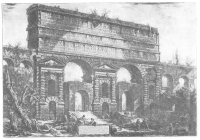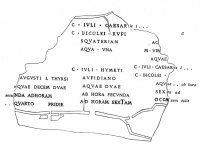


Inscriptions
Inscriptions are an important source of information regarding the aqueducts of Rome. In lieu of examining the original inscriptions, the Corpus Inscriptionum Latinarum 'CIL' is used. The most important inscriptions related to Rome are in Volume 6, especially CIL 6.1243 - CIL 6.1268.There are some limitations in using epigraphic evidence. One such limitation is that none of the inscriptions are earlier than the Augustan age (Sandys, 1927:129). Another is that inscriptions where not always intended to record fact; ancient politicians and emperors were well understood the value of propaganda.
We will now examine some of the important extant inscriptions.
Porta Praenestina / Porta Maggiore
Above the rough stones of the arches of the Porta Praenestina, or Porta Maggiore, the smooth walls of the channels carries three inscriptions. The top inscription is bordered above and below by stone slabs that project from the roof and floor of the Anio Novus channel (Aicher, 1995:54). The inscription reads (CIL 6.1256):TI. CLAUDIUS DRUSI F. CAISAR AUGUSTUS GERMANICUS PONTIF. MAXIM.,
TRIBUNICIA POTESTATE XII, COS. V, IMPERATOR XXVII, PATER PATRIAE,
AQUAS CLAUDIAM EX FONTIBUS, QUI VOCABANTUR CAERULEUS ET CURTIUS A MILLIARIO XXXXV,
ITEM ANIENEM NOVAM A MILLIARIO LXII SUA IMPENSA IN URBEM PERDUCENDAS CURAVIT.
The second inscription is framed by horizontal mouldings that extend the floor and roof of the Claudia conduit. It reads (CIL 6.1257):
IMP. CAESAR VESPASIANUS AUGUST. PONTIF. MAX., TRIB. POT. II, IMP. VI, COS. III DESIG. IIII, P.P.,
AQUAS CURTIAM ET CAERULEAM PERDUCTAS A DIVO CLAUDIO ET POSTEA INTERMISSAS DILAPSASQUE
PER ANNOS NOVEM SUA IMPENSA URBI RESTITUIT.
The third and lowest inscription on the Porta Maggiore is framed in a space below the two channels, giving the false impression of a third channel below. The channel that can be seen there is in fact the Acqua Felice, built in the 16th century. The inscription reads (CIL 6.1258):
IMP. T. CAESAR DIVI F. VESPASIANUS AUGUSTUS PONTIFEX MAXIMUS, TRIBUNIC.
POTESTATE X, IMPERATOR XVII, PATER PATRIAE, CENSOR, COS. VIII
AQUAS CURTIUM ET CAERULEAM PERDUCTAS A DIVO CLAUDIO ET POSTEA
A DIVO VESPASIANO PATRE SUO URBI RESTITAS, CUM A CAPITE AQUARUM A SOLO VETUSTATE DILAPSAE ESSENT, NOVA FORMA REDUCENDAS SUA IMPENSA CURAVIT
Porta Tiburtina
The Porta Tiburtina was originally a monumental aqueduct crossing. Later it was made into a gate in the Aurelian Wall. The partitioning of the three channels above the arch is very similar in design to Porta Maggiore. The travertine facing of the middle channel shows the traces that the moulding of this original archway formed a pediment here. Caracalla chiselled this off for an inscription recording his restoration of the Marcia in 212 AD. There are, like the Porta Maggiore, three inscriptions of interest here. The first (CIL 6.1244):IMP. CAESAR DIVI IULI F. AUGUSTUS PONTIFEX MAXIMUS COS. XII TRIBUNIC. POTESTAT. XIX IMP. XIIII RIVOS AQUARUM OMNIUM REFECIT.
IMP. CAES. M. AURELLIUS ANTONINUS PIUS FELIX AUG. PARTH. MAX. BRIT. MAXIMUS PONTIFEX \\MAXIMUS AQUAM MARCIAM VARIIS KASIBUS IMPEDITAM, PURGATO FONTE, EXCISIS ET PERFORATIS MONTIBUS, RESTITUTA FORMA, ADQUISITO ETIAM FONTE NOVO ANTONINIANO, IN SACREM URBEM SUAM PERDUCENDAM CURAVIT.
IMP. TITUS CAESAR DIVI F. VESPASIANUS AUG. PONTIF. MAX.
TRIBUNICIAE POTESTAT. IX IMP. XV CENS. COS. VII DESIG. IIX P.P.
RIVOM AQUAE MARCIAE VETUSTATE DILAPSUM REFECIT
ET AQUAM QUAEIN USU ESE DESIERAT REDUXIT.
Aqua Traiani
Another important inscription is to be found in CIL 6.1260, which dates the construction of the Aqua Traiani to 109 A.D. This is particularly useful, as we have little documentary evidence for the Traiani.AES[A]
[N]ERVAE . F . N[ERVA]
[T]RAIANVS . A[UG]
GERM . DACIC
[PO]NT . MAX. TR. POT. XI[II]
IMP . VI . COS . V . P .P
AQVAM . TRAIANAM
PECVNIA . SVA
IN VRBEM . PERDVXIT
EMPTIS . LOCIS
PER . LATITVD . P . XXX .
Miscellaneous inscriptions
CIL 1.808 is a valuable inscription that gives insight into the cost of construction in republican Rome.OPERA . L[OC]
IA . CAECILIA DE . H
D . MIL . XXXV . PONTEM . IN . FLVIO
A . AD . TRIBVTA . EST . POPVLO . CONST
Q . PAMPHILO . MANCVPI . ET OPE
[V]IAR . T . VIBIO . TEMVVDINO . Q . VRB
REA STERNENDA . AF . MIL
[P]ENNINVM . MVVNIE[N]
XX PECUNIA . AD . tRIB[VTA]
ONST HS N[] . L[] RVFILIO L . L .I
[S]TI MANCUPI CVR . VIAR . T . T . VIP
[M]IL . LXX[]III . AD MIL . CX
LA INTERAMNIVM . V[O]
XX . PECVNIA . AD. TRI
LO . CONST . HS []
T . SEPVNIO . T . F . O
R . T VIBIO / - M
ARCVS DE LA
MANCVPI
Q VRB
AQUA PINCIANA
D N FL VALENTINIA
NI AVG
Q . POMPEIVS BITHYNICI . L . SOSVS
SATRIENA . P . L . SALVIA . VXSOR . FRVG
OPSEQVENTES . ET . CONCORDES . ESQVILEIS . AB . AQUA
CONCLVSA . FECER . SIREI ET . SVEIS . ET DIGNEIS
DVM . SVPPEDITAT . VITA . INTER NOS . ANNOS . LX . VIXIM VS . CONCORDES
MORTE . OBITA . VT . MONVMENT[]VM . HABEREMVS . FECIMVS . VIVI
STVDIUM . ET . ACME . L . VT . VNA . CONDEREMVS . CONDITIVOM
CVBICVLVM . FECERVNT
Soter is specifically referred to as a public slave. As a castellarius, he would have been in charge of the castella of the Anio Vetus.
D . M
SOTER . SERVOS . PVBLICVS
CASTELLAR . AQVAE . ANNIONIS
VETERIS . FECIT . CONIVGI . BENE
MERENTI . ET . L . CALPVRNIVS
FLAVIANVS . MATRI . BENE
MERENTI . SIBI . ET . SVIS
POSTERISQVE . EORUM
MAR
IMP . CAESAR
DIVI . F . AVGVSTVS
EX . S . C
C inftyXX . P CCXI